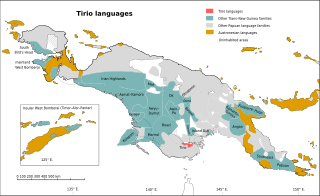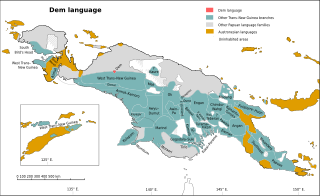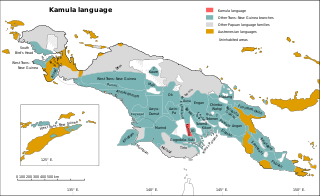Related Research Articles
The Yuat languages are an independent family of five Papuan languages spoken along the Yuat River in East Sepik Province, Papua New Guinea. They are an independent family in the classification of Malcolm Ross, but are included in Stephen Wurm's Sepik–Ramu proposal. However, Foley and Ross could find no lexical or morphological evidence that they are related to the Sepik or Ramu languages.
Isirawa is a Papuan language spoken by about two thousand people on the north coast of Papua province, Indonesia. It's a local trade language, and use is vigorous. Stephen Wurm (1975) linked it to the Kwerba languages within the Trans–New Guinea family, and it does share about 20% of its vocabulary with neighboring Kwerba languages. However, based on its pronouns, Malcolm Ross (2005) felt he could not substantiate such a link, and left it as a language isolate. The pronouns are not, however, dissimilar from those of Orya–Tor, which Ross links to Kwerba, and Donahue (2002) accept it as a Greater Kwerba language.
The Karkar language, also known as Yuri, is the sole Eastern Pauwasi language of Papua New Guinea. There are about a thousand speakers along the Indonesian border spoken in Green River Rural LLG, Sandaun Province.
Usku, or Afra, is a nearly extinct and poorly documented Papuan language spoken by 20 or more people, mostly adults, in Usku village, Senggi District, Keerom Regency, Papua, Indonesia.
Elseng is a poorly documented Papuan language spoken by about 300 people in the Indonesian province of Papua. It is also known as Morwap, which means "what is it?" ‘Morwap’ is vigorously rejected as a language name by speakers and government officials.
The Pauwasi languages are a likely family of Papuan languages, mostly in Indonesia. The subfamilies are at best only distantly related. The best described Pauwasi language is Karkar, across the border in Papua New Guinea. They are spoken around the headwaters of the Pauwasi River in the Indonesian-PNG border region.

The Tirio languages are a family of Trans–New Guinea languages in the classification of Malcolm Ross. The Tirio languages have about 40% of their lexicon in common.
Makolkol is a possible Papuan language formerly spoken on the Gazelle Peninsula of East New Britain Province on the island of New Britain, Papua New Guinea. Stebbins (2010) reports it is unattested. Palmer (2018) treats it as unclassified.

Dem is a divergent Papuan language of West New Guinea. Although Palmer (2018) leaves it unclassified, it was tentatively included in the Trans–New Guinea family in the classification of Malcolm Ross (2005), and Timothy Usher ties it most closely to Amung.
Kapori (Kapauri) is a Papuan language of Pagai village in Airu District, Jayapura Regency, Papua, Indonesia.

Kamula is a Trans–New Guinea language that is unclassified within that family in the classification of Malcolm Ross (2005). Noting insufficient evidence, Pawley and Hammarström (2018) leave it as unclassified.
Molof is a poorly documented Papuan language spoken by about 200 people in Molof village, Senggi District, Keerom Regency.
Tofanma or Tofamna is a poorly documented Papuan language of Indonesia. Wurm (1975) placed it as an independent branch of Trans–New Guinea, but Ross (2005) could not find enough evidence to classify it. It appears to be related to Namla, a neighboring language.
Mawes is an extinct Papuan language of Indonesia.
The Arafundi languages are a small family of clearly related languages in East Sepik Province, Papua New Guinea. They are conjectured to be related to the Piawi and Madang languages. They are named after the Arafundi River.
The Lower Ramu or Ottilien–Misegian languages consist of two branches in the Ramu language family. They are all spoken in Yawar Rural LLG, Madang Province, Papua New Guinea.
Yetfa and Biksi are dialects of a language spoken in Jetfa District, Pegunungan Bintang Regency, Highland Papua, Indonesia, and across the border in Papua New Guinea. It is a trade language spoken in Western New Guinea up to the PNG border.
Maklew is a language of the proposed Trans-Fly – Bulaka River family in South Papua, Indonesia. It is known to be spoken in Welbuti village, Merauke Regency. It is thought to be closely related to the Yelmek Language.
The West Pauwasi languages are a likely family of Papuan languages spoken on the Indonesian side of New Guinea. They may either form part of a larger Pauwasi language family along with the Eastern Pauwasi languages, or it they could form an independent language family.
The Tebi–Towe languages, Wurm's West Pauwasi languages, are a pair of closely related languages of New Guinea, namely Tebi (Dubu) and Towei.
References
- ↑ Tebi at Ethnologue (18th ed., 2015) (subscription required)
- ↑ Im, Youn-Shim. 2005. Draft survey report on the Tebi language of Papua, Indonesia. Manuscript. SIL.
- ↑ Foley, William A. (2018). "The Languages of the Sepik-Ramu Basin and Environs". In Palmer, Bill (ed.). The Languages and Linguistics of the New Guinea Area: A Comprehensive Guide. The World of Linguistics. Vol. 4. Berlin: De Gruyter Mouton. pp. 197–432. ISBN 978-3-11-028642-7.